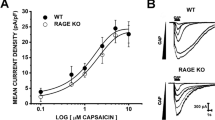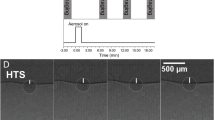Abstract
The mucosa of the proximal airways defends itself and the lower airways from inhaled irritants such as capsaicinoids, allergens, and infections by several mechanisms. Sensory nerves monitor the luminal microenvironment and release the tachykinin substance P (SP) to stimulate mucus secretion. Here, we have studied the role of the cystic fibrosis transmembrane conductance regulator (CFTR) in SP stimulation by comparing mouse airway submucosal gland responses in wild-type (WT) and CFTR−/− mice. Capsaicinoids (chili pepper oil) increased fluid secretion by glands from WT mice five-fold, and this response was abolished by exposing the basolateral aspect of the tracheas to L-732,138 (10 μmol/l), a specific antagonist of the neurokinin-1 receptor. Secretion was also stimulated 25-fold by basolateral application of SP, and this response was strongly inhibited by the CFTR inhibitor CFTRinh172. In contrast, submucosal glands from CFTR knockout mice failed to secrete when stimulated by SP (1 μmol/l), although those from wild-type control littermates were responsive. SP stimulation of wild-type glands was also abolished by clotrimazole (25 μmol/l), a blocker of Ca2+-activated K+ channels. These results indicate that SP mediates local responses to capsaicinoids through a mechanism involving coordinated activation of CFTR and K+ channels. To our knowledge, this is the first study in which CFTR-dependent responses to substance P have been directly demonstrated. Since CFTR regulation is qualitatively similar in human and mouse glands, loss of this local regulation in CF may contribute to reduced innate defenses in CF airways.





Similar content being viewed by others
References
Pilewski JM, Frizzell RA (1999) Role of CFTR in airway disease. Physiol Rev 79:S215–S255
Sheppard DN, Welsh MJ (1999) Structure and function of the CFTR chloride channel. Physiol Rev 79:S23–S45
Reid L (1960) Measurement of the bronchial mucous gland layer: a diagnostic yardstick in chronic bronchitis. Thorax 15:132–141
Trout L, Corboz MR, Ballard ST (2001) Mechanism of substance P-induced liquid secretion across bronchial epithelium. Am J Physiol Lung Cell Mol Physiol 281:L639–L645
Jayaraman S, Joo NS, Reitz B et al (2001) Submucosal gland secretions in airways from cystic fibrosis patients have normal [Na(+)] and pH but elevated viscosity. Proc Natl Acad Sci U S A 98:8119–8123
Joo NS, Irokawa T, Wu JV et al (2002) Absent secretion to vasoactive intestinal peptide in cystic fibrosis airway glands. J Biol Chem 277:50710–50715
Joo NS, Irokawa T, Robbins RC et al (2006) Hyposecretion, not hyperabsorption, is the basic defect of cystic fibrosis airway glands. J Biol Chem 281:7392–7398
Verkman AS, Song Y, Thiagarajah JR (2003) Role of airway surface liquid and submucosal glands in cystic fibrosis lung disease. Am J Physiol Cell Physiol 284:C2–C15
Wine JJ, Joo NS (2004) Submucosal glands and airway defense. Proc Am Thorac Soc 1:47–53
Salinas D, Haggie PM, Thiagarajah JR et al (2005) Submucosal gland dysfunction as a primary defect in cystic fibrosis. FASEB J 19:431–433
Song Y, Salinas D, Nielson DW et al (2006) Hyperacidity of secreted fluid from submucosal glands in early cystic fibrosis. Am J Physiol Cell Physiol 290:C741–C749
Phipps RJ, Richardson PS (1976) The effects of irritation at various levels of the airway upon tracheal mucus secretion in the cat. J Physiol 261:563–581
Schultz HD, Davis B, Coleridge HM et al (1991) Cigarette smoke in lungs evokes reflex increase in tracheal submucosal gland secretion in dogs. J Appl Physiol 71:900–909
Schultz HD, Roberts AM, Bratcher C et al (1985) Pulmonary C-fibers reflexly increase secretion by tracheal submucosal glands in dogs. J Appl Physiol 58:907–910
McBride RK, Oberdoerster G, Marin MG (1991) Effects of ozone on the cholinergic secretory responsiveness of ferret tracheal glands. Environ Res 55:79–90
Ianowski JP, Choi JY, Wine JJ et al (2007) Mucus secretion by single tracheal submucosal glands from normal and CFTR knock-out mice. J Physiol 580:301–314
Hunter DD, Undem BJ (1999) Identification and substance P content of vagal afferent neurons innervating the epithelium of the guinea pig trachea. Am J Respir Crit Care Med 159:1943–1948
Widdicombe JG (2003) Overview of neural pathways in allergy and asthma. Pulm Pharmacol Ther 16:23–30
Nemeth J, Helyes Z, Oroszi G et al (2003) Role of voltage-gated cation channels and axon reflexes in the release of sensory neuropeptides by capsaicin from isolated rat trachea. Eur J Pharmacol 458:313–318
McDonald DM (1987) Neurogenic inflammation in the respiratory tract: actions of sensory nerve mediators on blood vessels and epithelium of the airway mucosa. Am Rev Respir Dis 136:S65–S72
Phillips JE, Hey JA, Corboz MR (2003) Tachykinin NK3 and NK1 receptor activation elicits secretion from porcine airway submucosal glands. Br J Pharmacol 138:254–260
Haxhiu MA, Haxhiu-Poskurica B, Moracic V et al (1990) Reflex and chemical responses of trachea; submucosal glands in piglets. Respir Physiol 82:267–278
Ballard ST, Spadafora D (2007) Fluid secretion by submucosal glands of the tracheobronchial airways. Resp Physiol Neurobiol 159:271–277
Haston CK, McKerlie C, Newbigging S et al (2002) Detection of modifier loci influencing the lung phenotype of cystic fibrosis knockout mice. Mamm Genome 13:605–613
Kent G, Iles R, Bear CE et al (1997) Lung disease in mice with cystic fibrosis. J Clin Invest 100:3060–3069
Joo NS, Wu JV, Krouse ME et al (2001) Optical method for quantifying rates of mucus secretion from single submucosal glands. Am J Physiol Lung Cell Mol Physiol 281:L458–L468
Quinton PM (1979) Composition and control of secretions from tracheal bronchial submucosal glands. Nature 279:551–552
Szallasi A (2001) Vanilloid receptor ligands: hopes and realities for the future. Drugs Aging 18:561–73
Solway J, Leff AR (1991) Sensory neuropeptides and airway function. J Appl Physiol 71:2077–2087
Barnes PJ (2001) Neurogenic inflammation in the airways. Respir Physiol 125:145–154
Webber SE, Lim JC, Widdicombe JG (1991) The effects of calcitonin gene-related peptide on submucosal gland secretion and epithelial albumin transport in the ferret trachea in vitro. Br J Pharmacol 102:79–84
Shimura S, Sasaki T, Okayama H et al (1987) Effect of substance P on mucus secretion of isolated submucosal gland from feline trachea. J Appl Physiol 63:646–653
Haston CK, Cory S, Lafontaine L et al (2006) Strain-dependent pulmonary gene expression profiles of a cystic fibrosis mouse model. Physiol Genomics 25:336–345
Smith PL, Frizzell RA (1984) Chloride secretion by canine tracheal epithelium: IV. Basolateral membrane K permeability parallels secretion rate. J Membr Biol 77:187–199
McCann JD, Welsh MJ (1990) Basolateral K+ channels in airway epithelia. II. Role in Cl− secretion and evidence for two types of K+ channel. Am J Physiol 258:L343–L348
Devor DC, Singh AK, Bridges RJ et al (1996) Modulation of Cl− secretion by benzimidazolones. II. Coordinate regulation of apical GCl and basolateral GK. Am J Physiol 271:L785–795
Devor DC, Singh AK, Lambert LC et al (1999) Bicarbonate and chloride secretion in Calu-3 human airway epithelial cells. J Gen Physiol 113:743–760
Moon S, Singh M, Krouse ME et al (1997) Calcium-stimulated Cl− secretion in Calu-3 human airway cells requires CFTR. Am J Physiol 273:L1208–L1219
Moser AJ, Gangopadhyay A, Bradbury NA et al (2007) Electrogenic bicarbonate secretion by prairie dog gallbladder. Am J Physiol Gastrointest Liver Physiol 292:G1683–G1694
Geppetti P, Bertrand C, Bacci E et al (1993) Characterization of tachykinin receptors in ferret trachea by peptide agonists and nonpeptide antagonists. Am J Physiol Lung Cell Mol Physiol 265:L164–169
Meini S, Mak JC, Rohde JA et al (1993) Tachykinin control of ferret airways: mucus secretion, bronchoconstriction and receptor mapping. Neuropeptides 24:81–89
Wagner U, Fehmann HC, Bredenbroker D et al (1999) Effects of selective tachykinin-receptor antagonists on tachykinin-induced airway mucus secretion in the rat. Neuropeptides 33:55–61
Rogers DF, Aursudkij B, Barnes PJ (1989) Effects of tachykinins on mucus secretion in human bronchi in vitro. Eur J Pharmacol 174:283–286
Ballard ST, Inglis SK (2004) Liquid secretion properties of airway submucosal glands. J Physiol 556:1–10
Grandordy BM, Frossard N, Rhoden KJ et al (1988) Tachykinin-induced phosphoinositide breakdown in airway smooth muscle and epithelium: relationship to contraction. Mol Pharmacol 33:515–519
Jones LM, Michell RH (1978) Enhanced phosphatidylinositol breakdown as a Ca-independent response of rat parotid fragments to substance P. Biochem Soc Trans 6:1035–1037
Hanley MR, Lee CM, Jones LM et al (1980) Similar effects of substance P and related peptides on salivation and phosphatidylinositide turnover in rat salivary glands. Mol Pharmacol 18:78–83
Bristow DR, Suman-Chauhan N, Watling KJ (1987) Effect of tachykinins on inositol phospholipids hydrolysis in slices of urinary bladder. Br J Pharmacol 90:211–218
Khawaja AM, Rogers DF (1996) Tachykinins: receptor to effector. Int J Biochem Cell Biol 28:721–738
Lee JR, Limberis MP, Hennessy MF (2007) Optical imaging of Ca2+-evoked fluid secretion by murine nasal submucosal gland serous acinar cells. J Physiol 582:1099–1124
Petersen OH, Maruyama Y (1984) Calcium-activated potassium channels and their role in secretion. Nature 307:693–696
Choi JY, Joo NS, Krouse ME et al (2007) Synergistic airway gland secretion to vasoactive intestinal peptide and carbachol is lost in cystic fibrosis. J Clin Invest 117:3118–3127
Hanley MR, Lee CM, Michell RH et al (1980) Similar effects of substance P and related peptides on salivation and on phosphatidylinositol turnover in rat salivary glands. Mol Pharmacol 18:78–83
Tachado SD, Akhtar RA, Yousufzai SY et al (1991) Species differences in the effects of substance P on inositol trisphosphate accumulation and cyclic AMP formation, and on contraction in isolated iris sphincter of the mammalian eye: differences in receptor density. Exp Eye Res 53:729–739
Nakajima Y, Tsuchida K, Negishi M et al (1992) Direct linkage of three tachykinin receptors to stimulation of both phosphatidylinositol hydrolysis and cyclic AMP cascades in transfected Chinese hamster ovary cells. J Biol Chem 267:2437–2442
Fukuhara S, Shimizu M, Matsushima H et al (1998) Signaling pathways via NK1 receptors and their desensitization in an AR42J cell line. Peptides 19:1349–1357
Nagaki M, Ishihara H, Shimura S et al (1994) Tachykinins induce a [Ca2+]i rise in the acinar cells of feline tracheal submucosal gland. Respir Physiol 98:111–120
De Swert KO, Joos GF (2006) Extending the understanding of sensory neuropeptides. Eur J Pharmacol 533:171–181
Kreda SM, Mall M, Mengos A et al (2005) Characterization of wild-type and deltaF508 cystic fibrosis transmembrane regulator in human respiratory epithelia. Mol Biol Cell 16:2154–2167
Wine JJ (2007) Parasympathetic control of airway submucosal glands: central reflexes and the airway intrinsic nervous system. Auton Neurosci 33:35–54
Acknowledgments
We thank Dr. Mauri Krouse (Stanford) for stimulating discussions, Dr. Christina Haston (McGill) for providing the cftr+/− breeders, and Melanie Lafleur and Josée Paradis at McGill for much helpful technical advice concerning the mice. JPI was supported by a Fellowship from the Canadian CF Foundation and JYC by Cystic Fibrosis Research Inc. The work was supported by the CCFF and Canadian Institutes of Health Research through the BREATHE program and by grants from the Cystic Fibrosis Foundation (USA) and by the NIDDK of the National Institutes of Health (DK-51817).
Author information
Authors and Affiliations
Corresponding author
Rights and permissions
About this article
Cite this article
Ianowski, J.P., Choi, J.Y., Wine, J.J. et al. Substance P stimulates CFTR-dependent fluid secretion by mouse tracheal submucosal glands. Pflugers Arch - Eur J Physiol 457, 529–537 (2008). https://doi.org/10.1007/s00424-008-0527-0
Received:
Accepted:
Published:
Issue Date:
DOI: https://doi.org/10.1007/s00424-008-0527-0




